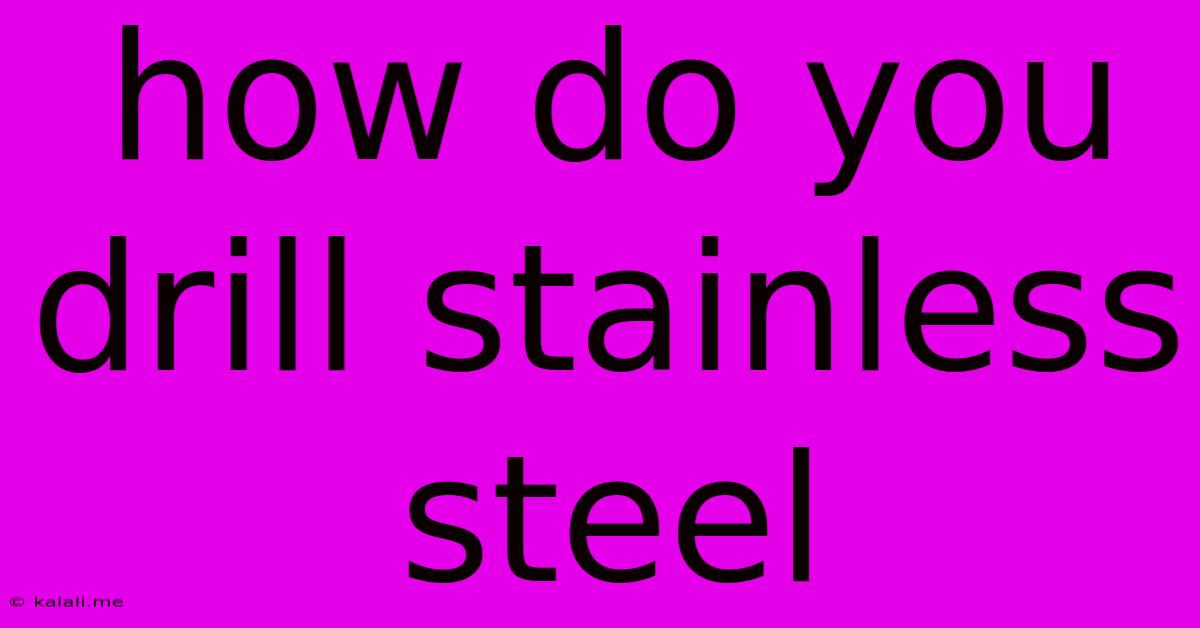How Do You Drill Stainless Steel
Kalali
Jun 01, 2025 · 3 min read

Table of Contents
How to Drill Stainless Steel: A Comprehensive Guide
Drilling stainless steel can be challenging, but with the right techniques and tools, you can achieve clean, precise holes every time. This guide covers everything you need to know, from choosing the right drill bit to preventing heat buildup and ensuring a successful drilling experience. This comprehensive guide will cover the essential steps, tools, and techniques for drilling stainless steel effectively and safely.
Choosing the Right Drill Bit: The key to successfully drilling stainless steel lies in selecting the appropriate drill bit. Standard high-speed steel (HSS) bits are often insufficient, especially for thicker gauges of stainless steel. Instead, you should consider these options:
-
Cobalt Drill Bits: These bits contain cobalt, which significantly increases their hardness and heat resistance. Cobalt bits are ideal for drilling stainless steel and are a great all-around choice for various thicknesses. They are generally more expensive but provide superior performance and longevity.
-
Titanium Nitride (TiN) Coated Drill Bits: The TiN coating reduces friction and heat generation during drilling, extending the life of the bit and producing cleaner holes. This is a good budget-friendly alternative to cobalt bits, offering a good balance of performance and cost.
-
Carbide Drill Bits: These bits are exceptionally hard and durable, making them suitable for extremely thick or hard stainless steel. They are the best option for heavy-duty applications but come with a higher price tag.
Essential Tools and Supplies: Beyond the drill bit, you'll need a few other essential tools and supplies:
-
Drill Press or Sturdy Drill: A drill press provides the stability and control necessary for precise drilling, especially in thicker materials. If using a handheld drill, ensure it's powerful enough and you can maintain firm control.
-
Cutting Fluid or Lubricant: This is crucial to prevent the drill bit from overheating and seizing, increasing the longevity of your drill bit and creating a smoother drilling process. Common cutting fluids include cutting oil, machine oil, or even water-soluble coolants.
-
Center Punch: To prevent the drill bit from wandering, use a center punch to create a small indentation at the drilling location. This provides a starting point for the drill bit and ensures accuracy.
-
Clamps or Vise: Securely clamping the stainless steel workpiece prevents movement and ensures a straight, clean hole. This is especially important when using a handheld drill.
Drilling Techniques for Success:
-
Start Slow: Begin drilling at a low speed to allow the drill bit to engage properly and prevent slippage. Gradually increase the speed as the hole deepens.
-
Apply Consistent Pressure: Maintain consistent downward pressure, avoiding excessive force which can break the bit or damage the workpiece.
-
Frequent Lubrication: Apply cutting fluid or lubricant frequently throughout the drilling process. This will help keep the bit cool, prevent clogging, and extend its lifespan.
-
Lift the Drill Periodically: To prevent heat buildup, periodically lift the drill bit to allow it to cool slightly. This will also prevent the bit from becoming clogged with metal shavings.
-
Pilot Holes (For Larger Holes): For larger diameter holes, it's best practice to drill a series of progressively larger pilot holes to guide the final drill bit and prevent breakage.
-
Clean Regularly: Regularly remove metal shavings from the hole with compressed air or a brush to keep the drill bit from clogging.
Troubleshooting Common Issues:
-
Drill Bit Overheating: This is a common problem, easily prevented by using cutting fluid and lifting the drill bit regularly.
-
Drill Bit Wandering: A center punch and firm clamping of the workpiece will help prevent this.
-
Broken Drill Bit: Ensure you are using the correct drill bit for the material thickness and apply consistent, but not excessive, pressure.
By following these steps and utilizing the appropriate tools, you can confidently drill stainless steel with precision and accuracy. Remember, patience and the right technique are key to a successful outcome. Always prioritize safety and wear appropriate personal protective equipment (PPE).
Latest Posts
Latest Posts
-
How To Open A Tube Of Caulk
Jun 02, 2025
-
Can You Shoot 38 In A 357
Jun 02, 2025
-
How To Get A Fire Extinguisher Recharged
Jun 02, 2025
-
Am I Using Wayland Or X11
Jun 02, 2025
-
Wiring Diagram For One Switch And Two Lights
Jun 02, 2025
Related Post
Thank you for visiting our website which covers about How Do You Drill Stainless Steel . We hope the information provided has been useful to you. Feel free to contact us if you have any questions or need further assistance. See you next time and don't miss to bookmark.